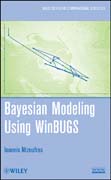
The BUGS (Bayesian inference Using Gibbs Sampling) project is concerned with free, flexible software for the Bayesian analysis of complex statistical models using Markov Chain Monte Carlo (MCMC) methods. It details the various and commonly-used modeling techniques that are employed by statisticians in a multitude of sciences such as; biostatistics and social science; actuarial science environments. This book presents the reader with a clear and easily accessible introduction to the use of WinBUGS programming techniques in a variety of Bayesian modeling settings. Emphasis is given to Generalized Linear Models (GLMs) familiar to most readers and researchers. Detailed explanations cover model building, prior specification, writing WinBUGS code, and analyzing and interpreting WinBUGS output. Also features comprehensive problems and examples. INDICE: List of Figures. List of Tables. Preface. Acknowledgments. Acronyms. 1. Introduction to Bayesian inference. 1.1 Introduction: Bayesian modeling in the 21st century. 1.2 Definition of statistical models. 1.3 Bayes theorem. 1.4 Model based Bayesian inference. 1.5 Inference using conjugate prior distributions. 1.6 Non Conjugate Analysis. Problems. 2. Markov Chain Monte Carlo Algorithms in Bayesian Inference. 2.1 Simulation, Monte Carlo integration and their implementation in Bayesian inference. 2.2 Markov chain Monte Carlo methods.2.3 Popular MCMC algorithms. 2.4 Summary and closing remarks. Problems. 3. The WinBUGSsoftware: Introduction, Set-up and Basic Analysis. 3.1 Introduction and historical background. 3.2 The WinBUGS environment. 3.3 Preliminaries on using WinBUGS. 3.4 Building Bayesian models in WinBUGS. 3.5 Compiling the model and simulating values. 3.6 Basic Output analysis using the Sample Monitor Tool. 3.7 Summarizing the procedure. 3.8 Chapter summary and concluding comments. Problems. 4. The WinBUGSSoftware: Illustration, Results and Further Analysis. 4.1 A complete example of running MCMC in WinBUGS for a simple model. 4.2 Further output analysis using the inference menu. 4.3 Multiple chains. 4.4 Changing the properties of a figure. 4.5 Other tools and menus. 4.6 Summary and concluding remarks. Problems. 5. Introduction to Bayesian models: Normal models. 5.1 General modeling principles. 5.2 Model specification in Normal regression models. 5.3 Using vectors and multivariate priors in normal regression models. 5.4 Analysis of variance models. Problems. 6. Incorporating categorical variables in normal modelss Method. 11.9 Reversible Jump MCMC (RJMCMC). 11.10 Using posterior predictive densities for model evaluation. 11.11 Information criteria. 11.12 Discussion and further reading. Problems. Appendix A: Model Specification via directed acyclic graphs: The Doodle menu. A.1 Introduction: Starting with DOODLE. A.2 Nodes. A.3 Edges. A.4 Panels. A.5 A simple example 457. Appendix B: The Batch Mode: Running a model in the background using scripts. B.1 Introduction. B.2 Basic commands: compiling and running the model. Appendix C: Checking Convergence Using CODA/BOA. C.1 Introduction. C.2 A short historical review. C.3 Diagnostics implemented by CODA/BOA. C.4 A first look of CODA/BOA. C.5 A Simple example. Appendix D: Notation Summary. D.1 MCMC. D.2 Subscripts and indexes. D.3 Parameters. D.4 Random Variables and Data. D.5 Sample estimates. D.6 Special Functions, Vectors and Matrices. D.7 Distributions. D.8 Distribution related notation. D.9 Notation used in ANOVA and ANCOVA. D.10 Variable and Model Specification. D.11 Deviance Information Criterion (DIC). D.12 Predictive Measures. References.
- ISBN: 978-0-470-14114-4
- Editorial: John Wiley & Sons
- Encuadernacion: Cartoné
- Páginas: 492
- Fecha Publicación: 13/02/2009
- Nº Volúmenes: 1
- Idioma: Inglés
